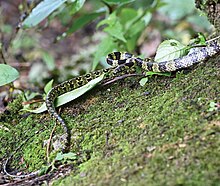Lycodon gammiei, commonly known as Gammie's wolf snake or the Sikkim false wolf snake, is a species of nonvenomous snake in the family Colubridae. The species is endemic to India.
| Lycodon gammiei | |
|---|---|

| |
| Lycodon gammiei | |
| Scientific classification | |
| Domain: | Eukaryota |
| Kingdom: | Animalia |
| Phylum: | Chordata |
| Class: | Reptilia |
| Order: | Squamata |
| Suborder: | Serpentes |
| Family: | Colubridae |
| Genus: | Lycodon |
| Species: | L. gammiei
|
| Binomial name | |
| Lycodon gammiei (Blanford, 1878)
| |
| Synonyms[2] | |
Etymology
editThe specific name, gammiei, is in honor of naturalist James Alexander Gammie (1839–1924), who managed a Cinchona plantation in Darjeeling from 1865 to 1897.[3]
Geographic range
editLycodon gammiei is found in northern India, in the states of Arunachal Pradesh and Sikkim, and in Darjeeling district in the state of West Bengal.[2]
Habitat
editDescription
editAt first glance, Gammie's wolf snake resembles the venomous kraits. Its body is encircled by alternating dark and light rings with irregular margins. Its head is dark olive, and there are light spots in the center of most head shields. It has an imperfect pale collar, and the underside of the head and neck are whitish. Adults are about 80 cm (32 inches) in total length (including tail).[4]
Reproduction
editReferences
edit- ^ a b Das, A.; Ghosh, A.; Wangyal, J. (2021). "Lycodon gammiei ". IUCN Red List of Threatened Species. 2021: e.T202842A2757271. doi:10.2305/IUCN.UK.2021-3.RLTS.T202842A2757271.en. Retrieved 28 May 2023.
- ^ a b c Lycodon gammiei at the Reptarium.cz Reptile Database. Accessed 17 June 2015.
- ^ Beolens, Bo; Watkins, Michael; Grayson, Michael (2011). The Eponym Dictionary of Reptiles. Baltimore: Johns Hopkins University Press. xiii + 296 pp. ISBN 978-1-4214-0135-5. (Dinodon gammiei, p. 97).
- ^ Boulenger GA (1893). Catalogue of the Snakes in the British Museum (Natural History). Volume I., Containing the Families ... Colubridæ Aglyphæ, part. London: Trustees of the British Museum (Natural History). (Taylor and Francis, printers). xiii + 448 pp. + Plates I-XXVIII. (Lycodon gammiei, p. 358).
Further reading
edit- Blanford WT (1878). "Notes on some Reptilia from the Himalayas and Burma". Journal of the Asiatic Society of Bengal 47 (part 2): 125–131. (Ophites gammiei, new species, pp. 130–131). (in English and Latin).
- Boulenger GA (1890). The Fauna of British India, Including Ceylon and Burma. Reptilia and Batrachia. London: Secretary of State for India in Council. (Taylor and Francis, printers). xviii + 541 pp. (Lycodon gammiei, new combination, p. 296).
- Siler, Cameron D.; Oliveros, Carl H.; Santanen, Anssi; Brown, Rafe M. (2013). "Multilocus phylogeny reveals unexpected diversification patterns in Asian wolf snakes (genus Lycodon)". Zoologica Scripta 42: 262–277.
- Wall F (1923). "A Hand-list of the Snakes of the Indian Empire. Part 2". Journal of the Bombay Natural History Society 29: 598–632. (Dinodon gammiei, new combination, p. 615).
- Smith MA (1943). The Fauna of British India, Ceylon and Burma, Including the Whole of the Indo-Chinese Sub-region. Reptilia and Amphibia. Vol. III.—Serpentes. London: Secretary of State for India. (Taylor and Francis, printers). xii + 583 pp. (Dinodon gammiei, p. 271).
- Mistry V (2007). "Rediscovery of the Sikkim False Wolf Snake". Hornbill (Jul–Sep): 18–19.
- Mistry V, Vogel G, Tillack F (2007). "Rediscovery of Dinodon gammiei (BLANFORD 1878) (Serpentes, Colubridae), with description of its validity". Hamadryad 31 (2): 265–273
- Agarwal I, Mistry VK, Athreya R (2010). "A preliminary checklist of the reptiles of Eaglenest Wildlife Sanctuary, West Kameng district, Arunachal Pradesh, India". Russian Journal of Herpetology 17 (2): 81–93.
- Athreya R (2006). Eaglenest Biodiversity Project (2003 – 2006): Conservation resources for Eaglenest wildlife sanctuary. Pune: Kaati Trust. 196 pp.
